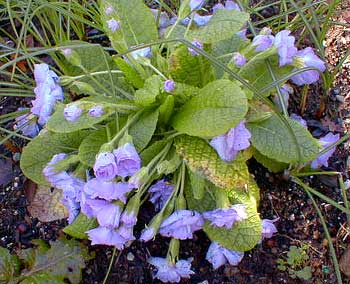
'Quaker's Bonnet' Primrose
aka, "Ladies' Delight"
aka "Lilacina Plena"
"Yes, Heaven is thine; but this
Is a world of sweets & sours;
Our flowers are merely flowers,
And the shadow of thy perfect bliss
Is the sunshine of ours."
-Edgar Allen Poe
This rose-violet, lilac, or orchid-pink frilly English double primrose (Primula vulgaris 'Quaker's Bonnet') has blooms that somewhat resemble miniature roses.
The nearly evergreen leaves tend to hide the first blooms that appear early & mid winter, but as the blossoms pick up steam toward the end of winter & early spring, they are quite showy.
If grown in pots the flowers tend to hang down over the edges of the pot in a very visible manner, but in the garden don't seem to have such long stems. They do not bloom so early or quite so long in less temperate zones, but remain hardy down to zone 5.
A true hierloom, 'Quaker's Bonnet' dates at least to 1835, & probably originated earlier still in Ireland. Such double primroses were very popular in Tudor gardens & 'Quaker's Bonnet' was as well known as any.
Ours grows on a rockery ledge under a Pin Oak, where it gets a lot of morning sun & indirect lighting later in the day. Among its companion perennials is a Blue Poppy & a drift of yellow Fuscotinctus crocuses, the post-bloom foliage showing around the Quaker's Bonnet in the above March photograph.
Not far along the same ledge is another long-flowering evergreen primrose, P. acaulis 'Finesse Red.' The 'Finesse Red' has seemed to weaken year by year in our garden; but the tough 'Quaker's Bonnet' remains a strong little plant with reliable winter & early spring floweriness.
It does well in part shade or sun, in persistently moist well-draining soil. The rosette of sturdy evergreen leaves is about eight to tench inches round, four or five inches high. Oversized clumps should be dug up & divided in Autumn, about every two to four years, which will reinvigorate the flowering.